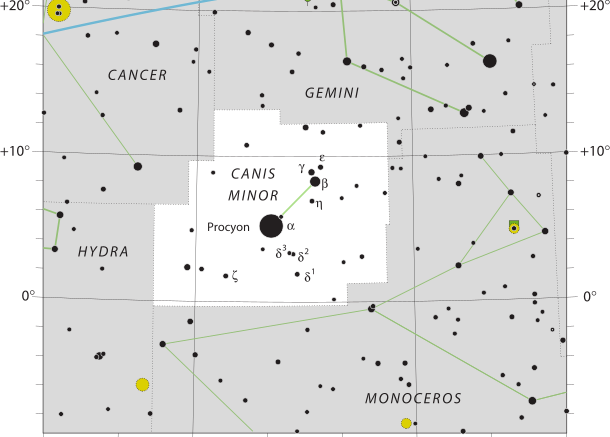Located in the northern celestial hemisphere, Canis Minor is a small constellation that was included in Ptolemy’s 2nd century constellations. The name is Latin for “lesser dog”, which is commonly represented as following the constellation of Orion the hunter. Canis Minor is 183 square degrees in size, which ranks 71st of 88th in regards to constellation size. The best time to see the constellation is in March.
Canis Minor contains only two stars brighter than the fourth magnitude, which are Procyon and Gomeisa. Procyon is notable as it is the 7th-brightest star in the night sky. There are 2 faint deep-sky objects within the constellation’s borders.
| Applicable Information | |
| Visibility In Pacific Northwest | September to April |
| Best Times To View | March |
| Right Ascension | 07h 06.4m to 08h 11.4m |
| Declination | 13.22° to −0.36° |
| Area | 183 square degrees |
| Main Stars | 2 |
| Brightest Object | Procyon |
| Meteor showers | Canis-Minorids |
| Messier objects | 0 |
| Neighboring Constellations | Monoceros, Gemini, Cancer, Hydra |
Mythology
The earliest mentions of Canis Major comes from ancient Mesopotamia from 1100BC.
In Greek mythology, Canis Minor was sometimes connected with the Teumessian Fox, which is a beast turned into stone with its hunter, who were placed into the heavens as Canis Major and Canis Minor.
Medieval Arabic astronomers kept the depiction of Canis Minor as a dog.
Ancient Egyptians imagined the constellation in the sky as representing the god Anubis.
In Chinese astronomy, the stars lie in the Vermilion Bird of the South.
The Aztec associated the constellation with an asterism associated with the day called “Water.”
Stars
Johann Bayer labelled the 8 most prominent stars with the Greek letters Alpha to Eta. John Flamsteed would count 14 more stars in the constellations.
Canis Minor contains 2 stars that are brighter than fourth magnitude, with the brightest star being Procyon. Its name means “before the dog” or “preceding the dog” in Greek, as it rises 1 hour before the “Dog Star”,
The Milky Way passes through much of Canis Minor, yet there are a few deep-sky objects. NGC 2459 is a group of five stars that appear to close together in the sky but are not related.
Make sure to check out other articles on the site, including a brief introduction to constellations, other constellation articles, and more!

Be the first to comment on "Canis Minor"